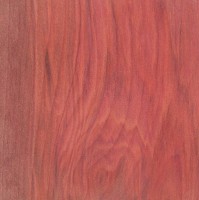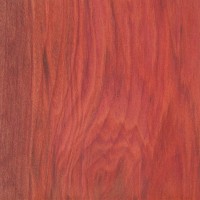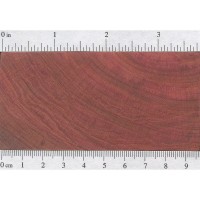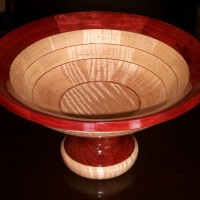 |
Common Name(s): Redheart, Chakte Kok Scientific Name: Erythroxylum spp. and Simira spp. Distribution: Southern Mexico to southern Brazil and Paraguay Tree Size: 50-65 ft (15-20 m) tall, 1-1.5 ft (.3-.5 m) trunk diameter Average Dried Weight: 40 lbs/ft3 (640 kg/m3) Specific Gravity (Basic, 12% MC): .52, .64 Janka Hardness: 1,210 lbf (5,380 N) Modulus of Rupture: 14,320 lbf/in2 (98.7 MPa) Elastic Modulus: 1,497,000 lbf/in2 (10.32 GPa) Crushing Strength: 6,690 lbf/in2 (46.2 MPa) Shrinkage: Radial: 2.8%, Tangential: 8.2%, Volumetric: 10.6%, T/R Ratio: 2.9 |
Color/Appearance: Aptly named, in some instances freshly surfaced Redheart can be a very bright, watermelon red—though color can vary in intensity and hue from board to board: anywhere from a light orange/pink, (similar to Pink Ivory), to a darker brownish red. In some cases, it can look quite similar to Bloodwood, though usually with a more visible and figured grain pattern. Redheart’s vibrant color quickly fades to a reddish brown in direct sunlight, though this color change can be slowed (but usually not stopped entirely) by using a finish with UV inhibitors, and keeping the wood away from strong lighting.
Grain/Texture: Grain is usually straight or irregular, with a fine, even texture. Low to medium natural luster.
Endgrain: Diffuse-porous; small to very small pores arranged predominantly in radial multiples of 2-5; growth rings indistinct; rays not visible without lens; parenchyma varies by species: sometimes rare or absent, or vasicentric and weakly aliform (winged).
Rot Resistance: Laboratory tests have shown Redheart to be moderately durable to attack by decay fungi.
Workability: Redheart has good working characteristics, and planes, machines, and sands well. Turns, glues, and finishes well, though a brown color shift is to be expected.
Odor: Redheart can have a distinct, rubber-like smell when being worked depending on species.
Allergies/Toxicity: Besides the standard health risks associated with any type of wood dust, no further health reactions have been associated with Redheart. See the articles Wood Allergies and Toxicity and Wood Dust Safety for more information.
Pricing/Availability: Sometimes available as narrow boards, but commonly available as turning squares. Tends to be on the medium to high side for an imported hardwood.
Sustainability: This wood species is not listed in the CITES Appendices or on the IUCN Red List of Threatened Species.
Common Uses: Turned objects, inlays, veneer, fine furniture, and small specialty wood items.
Comments: Commonly called Chakte Kok (with a multitude of variant spellings), this species has been previously placed in the Sickingia genus. Another species that’s also in the Rubiaceæ family is Cosmocalyx spectabilis, which is typically sold interchangeably as Chakte Kok. A third, botanically unrelated wood (Erythroxylaceæ family), which bears an uncanny similarity in nearly every respect to the two other species is Erythroxylum havanense, which is most commonly sold as Redheart.
The scans show examples of what is labeled as Redheart (Erythroxylum spp.), while the mechanical data numbers reference the wood referred to as Chakte Kok (Simira genus).
None available.
 |
 |
 |
 |
 |





A box in chakte kok/redheart
Door topper poinsettia, also with poplar, yellowheart, cherry and oak.
What is the best way to seal this wood when making a mantel?
Here’s an inlay with Red Heart. Sealed with a light coat of shellac. I use a UV inhibiting varnish to keep the color true.
So beautifull!
I like working Redheart on the lathe…holds details well, easy to sand and finish. Does tend to split and crack if not dried carefully.
It was raining in Playa del Carmen…behind the salvage yard When I found this pile of spectacular deep red wood! Now I know it’s name. Canadian, so it was new to me.
lucky find!!! make a table out of that wood if you took some
With this wood are also made wristwatches such as this photo, the Italian brand Woodstar Milano . https://woodstar.it
. https://woodstar.it
I love the watch
I have attached a picture of
some Celtic Lovespoons I carved from Redheart, for my 2 daughters. In
your wood type information brake down, you noted in the ODOR category,
(…a distinct, rubber-like smell when being worked…)
If you think that smell would be unpleasant, you should smell how bad
it is when using a wood burning tool. My wife said the smell lingered
in the house for about 2 days.
There are 3 species of trees where the wood looks almost the same.
Chakte-kok Simira salvadorensis
Chakte-kok Cosmocalyx spectabilis
Red Heart Erythroxylon havanense
With a hand lens or a good microscope, do you know how to separate these three.
I call these three (3) the “The 3 Red Look-a-Likes”
Duane Keck IWCS # 9086
I’ve been wondering the very same thing myself. To date, I have no idea how to tell these species apart. (Which is part of the reason why I’ve merged them into the same page.)
On a related note, I think wood vendors may be starting to call everything “Redheart” instead of “Chakte Kok” simply because it sounds better and probably sells more wood that way. Perhaps the distinction between these species is being blurred even further.
I have used Redheart in a project with silver wire inlaid in the wood.
It was easy to work with, no splitting issues even when I used downward force to split the grain for the silver wire.
The color has been the same months after being finish sanded.
I just had this happen to a Macassar Ebony blank I was drilling. It split lengthwise. This can happen for a number of reasons: Usually there’s a defect or irregularity present in the wood. (This shouldn’t be a deal-breaker though, as it’s still possible to drill pretty frail and fragile wood.) The biggest thing is if you’re drilling the blank too fast — that is to say, you’re using too much downward pressure. I tend to like a higher speed (not insanely fast) when drilling pen blanks, and then just let the bit do the cutting for you. This way… Read more »
Well today in wood shop my buddy buddy Alex was drilling a red heart pen blank for me when he brought it back to me the cracked unexpectedly during the drilling process, Eric do you have any advice?
~Trevor
I just purchased a Redheart pen blank it is redish-brown in color, will the color change once I turn it, how long will the color stay?
I have attached a picture of some Celtic Lovespoons I carved from Redheart, for my 2 daughters. In your wood type information brake down, you noted in the ODOR category,
(…a distinct, rubber-like smell when being worked…)
If you think that smell would be unpleasant, you should smell how bad it is when using a wood burning tool. My wife said the smell lingered in the house for about 2 days.
Duane,
I’ve been wondering the very same thing myself. To date, I have no idea how to tell these species apart. (Which is part of the reason why I’ve merged them into the same page.)
On a related note, I think wood vendors may be starting to call everything “Redheart” instead of “Chakte Kok” simply because it sounds better and probably sells more wood that way. Perhaps the distinction between these species is being blurred even further.
There are 3 species of trees where the wood looks almost the same.
Chakte-kok Simira salvadorensis
Chakte-kok Cosmocalyx spectabilis
Red Heart Erythroxylon havanense
With a hand lens or a good microscope, do you know how to separate these three.
I call these three (3) the “The 3 Red Look-a-Likes”
Duane Keck IWCS # 9086